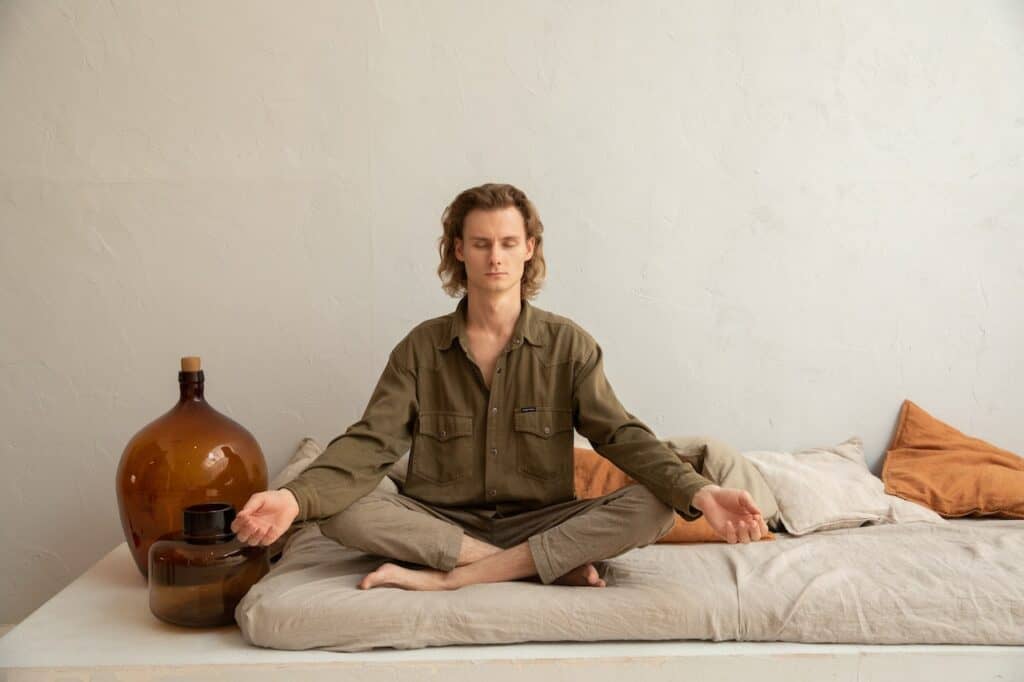Ashtanga Yoga, a term that resonates deeply within the yoga community, is a dynamic and structured practice that has captivated the hearts of many.
Rooted in ancient Indian traditions, this form of yoga offers a holistic approach to well-being, harmonizing the body, mind, and spirit.
Ashtanga Yoga
We’ll explore the depths of Ashtanga Yoga, shedding light on its history, philosophy, and the transformative power it holds. This practice is not just about physical postures; it’s a lifestyle, a philosophy, and a journey of self-discovery.

The origins of Ashtanga Yoga can be traced back to the ancient Indian sage Patanjali, who penned the Yoga Sutras over 2,000 years ago.
This seminal text, comprising 196 aphorisms, lays the foundation for various yoga practices, with Ashtanga Yoga being one of its most profound manifestations.
The teachings have been passed down through generations, with each era adding its unique touch while preserving the essence. Sri K. Pattabhi Jois, in the 20th century, played a pivotal role in bringing Ashtanga to the global stage, making Mysore the epicenter of this practice.
Eight Limbs of Ashtanga
The term “Ashtanga” is derived from Sanskrit, with “Ashta” meaning eight and “Anga” denoting limbs.
These eight limbs serve as guiding principles, leading practitioners toward spiritual enlightenment.
They are not just steps but intertwined aspects that collectively elevate one’s life. Delving into each limb:
- Yama: These are the ethical standards we set for ourselves, shaping our interactions with the world. They teach us compassion, truth, and integrity.
- Niyama: These personal observances are akin to self-care rituals, nurturing our inner world. They emphasize cleanliness, contentment, and spiritual reflection.
- Asana: Beyond mere physical postures, asanas are tools to calm the mind and prepare it for meditation. They teach discipline, patience, and perseverance.
- Pranayama: This is the art of breath control. By mastering our breath, we can control our emotions, thoughts, and energy.
- Pratyahara: In today’s world of constant stimuli, this limb teaches us to withdraw and find solace within, promoting introspection.
- Dharana: In an age of distractions, this principle of concentration is more relevant than ever. It’s the foundation for deep meditation.
- Dhyana: This is the actual practice of meditation, where one observes without attachment, reaching a state of pure consciousness.
- Samadhi: The ultimate goal, it’s a state of ecstasy and union with the divine.
It’s a glimpse of enlightenment, the merging of the self with the universe.

Series in Ashtanga Yoga
Ashtanga Yoga is structured into different sequences or series, each with a specific focus. These series are like milestones on the Ashtanga path, guiding practitioners from the basics to advanced postures.
- Primary Series:
Known as “Yoga Chikitsa,” this series is therapeutic.
It detoxifies and aligns the body, laying the foundation for deeper practices. - Intermediate Series:
Termed “Nadi Shodhana,” it focuses on purifying the energy channels or nadis.
This series introduces more complex postures, demanding increased flexibility and strength. - Advanced Series:
Divided into four series (A, B, C, D), collectively called “Sthira Bhaga,” these sequences are for seasoned practitioners. They challenge the body and mind, pushing boundaries and deepening one’s practice.
| Sequence | Focus Area |
|---|---|
| Sun Salutations | Warm-up |
| Standing Poses | Strength and Balance |
| Seated Poses | Flexibility and Alignment |
| Closing Sequence | Relaxation |
Each series progresses in complexity, allowing practitioners to evolve in their practice.
It’s essential to master one series before advancing to the next, ensuring safety and proper development.
The journey through these series is not just physical; it’s an exploration of one’s limits, capabilities, and potential.
Core Principles
Three core principles underpin Ashtanga Yoga:
- Vinyasa: This refers to the synchronization of breath with movement.
Each asana corresponds to a specific number of breaths, creating a rhythmic flow.
This continuous movement generates heat, detoxifying the body and sharpening the mind. - Drishti: Drishti, or gaze, directs attention during practice.
There are nine drishtis in Ashtanga, guiding focus and aiding concentration.
They anchor the mind, preventing it from wandering. - Bandhas: These are energy locks that control the flow of prana.
Engaging the bandhas stabilizes the core, supports the spine, and harnesses energy, making it flow in the desired direction.

Benefits of Ashtanga Yoga
The rewards of practicing Ashtanga Yoga are manifold:
- Physical Strength: The rigorous sequences build muscle tone, endurance, and flexibility.
Over time, practitioners notice improved posture, agility, and overall vitality. - Mental Clarity: The emphasis on breath and focus sharpens the mind, enhancing concentration and reducing stress. It’s a tool for mental resilience, helping one navigate life’s challenges with equanimity.
- Spiritual Growth: By adhering to the eight limbs, practitioners embark on a spiritual journey, fostering self-awareness and inner peace. It’s a path to self-realization, where one discovers their true nature.
- Detoxification: The continuous flow generates internal heat, promoting detoxification through sweat. This purification process rejuvenates the body, enhancing energy levels and boosting immunity.
- Emotional Balance: Regular practice can lead to emotional stability, resilience, and a positive outlook. It’s therapy for the soul, healing emotional wounds, and fostering joy.
Modern-day Ashtanga Yoga
Today, Ashtanga Yoga enjoys global recognition, with schools and shalas proliferating worldwide.
The Mysore style, a self-paced approach where students practice independently under a teacher’s guidance, remains the most authentic form. This method allows for personalized adjustments and fosters self-reliance.
Prominent figures like Sharath Jois, the grandson of Pattabhi Jois, continue to propagate the tradition, ensuring its authenticity and relevance in contemporary times.
Workshops, retreats, and teacher training programs are now accessible in most parts of the world, making Ashtanga a global phenomenon.

Getting Started with Ashtanga
Embarking on the Ashtanga journey requires dedication and patience:
- Find a Certified Teacher: Begin with a knowledgeable guide who can provide proper instruction and adjustments. A good teacher can make a world of difference, ensuring you understand the nuances of each posture and practice safely.
- Consistency is Key: Regular practice, ideally six days a week, accelerates progress. Like any discipline, consistency yields results. Over time, the practice becomes a part of one’s daily routine, something to look forward to.
- Listen to Your Body: While it’s essential to push boundaries, it’s equally crucial to recognize limits. Honor your body, understanding that progress is incremental.
- Diet and Lifestyle: A balanced diet and a sattvic (pure) lifestyle complement the practice. Ashtanga is not just about the time spent on the mat; it’s a way of life. Incorporating principles of non-violence, truth, and purity in daily life enhances the overall experience.
- Join a Community: Engaging with fellow practitioners provides motivation and support. Sharing experiences, challenges, and breakthroughs enriches the journey, making it more fulfilling.
The Role of Diet
In Ashtanga Yoga, the body is considered a temple, and what we consume directly impacts our practice.
A sattvic diet, derived from the Sanskrit word ‘Sattva’ meaning purity, is recommended. This diet emphasizes:
- Fresh fruits and vegetables
- Whole grains and nuts
- Dairy products, especially milk, and ghee
- Natural sweeteners like honey or jaggery
- Spices like turmeric, ginger, and cumin
Avoiding tamasic (stale or over-processed) and rajasic (overly spicy or stimulating) foods helps maintain balance.
Many Ashtangis also adopt vegetarianism, aligning with the principle of ‘Ahimsa’ or non-violence, ensuring that their food choices reflect their ethical and spiritual values.

The Global Ashtanga Community
The Ashtanga community transcends borders.
With its roots in Mysore, India, it has branched out globally, with shalas in almost every major city worldwide.
International retreats, workshops, and festivals offer practitioners opportunities to immerse themselves in intensive practice, learn from renowned teachers, and connect with fellow Ashtangis.
Events like the Bali Spirit Festival, Ashtanga Yoga Confluence, and others celebrate the unity and diversity of this global community.
Common Misconceptions
Several myths surround Ashtanga Yoga:
- It’s Only for the Physically Fit: While demanding, Ashtanga is adaptable. Everyone, irrespective of age or fitness, can embark on this journey. The practice meets you where you are, allowing for modifications and variations.
- It’s Rigid: The sequences are structured, but there’s flexibility in terms of pace and modifications. The rigidity is in the discipline, not in the approach.
- It’s Merely Physical: The asanas are just one of the eight limbs. The practice is as much spiritual as it is physical. It’s a holistic approach, addressing every facet of human existence.

Long Story Short
Ashtanga Yoga, with its rich history and profound philosophy, offers a transformative experience.
It’s a path that beckons the seeker, promising physical vitality, mental clarity, and spiritual awakening.
Whether you’re a novice or a seasoned yogi, Ashtanga Yoga provides a canvas to explore the depths of your being, one breath at a time. Embracing this practice is embracing a life of purpose, passion, and profound peace.
If you liked this, you are going to love the post on 16 Types of Yoga
